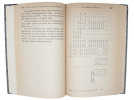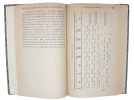3 books for « mendeleev mendelejeff... »Edit
-
Topics
Chemistry (3)
Tea (1)
"MENDELÉEV (MENDELEJEFF, MENDELEYEV, MENDELÉEFF), DIMITRY IVANOVICH.
Reference : 44839
(1869)
Ueber die Verbindungen des Alkohols mit Wasser. Im Auszuge aus d. russischen Originalarbeit von Victor Richter. (On the Compounds of Alcohol with Water). (2 Theile).
Leipzig, Johann Ambrosius Barth, 1869. Conemp. hcalf. 5 raised bands, gilt spine and gilt lettering to spine. A few scratches to spine. Small stamp on verso of first -and general- titlepage and small stamps to verso of plates. In: ""Annalen der Physik und Chemie. Hrsg. von J.C. Poggendorff"", Fünfte Reihe Bd. 18 (138. Bd. der Reihe). X,652 pp. a. 6 folded plates (The entire volume offered). Mendeléev's paper: pp. 103-141 a. pp. 230-279. Clean and fine.
First German edition of Mendeléev's doctoral dissertation ""O soedineni spirta s vodoyu"" from 1865. ""In it he first developed the characteristic view that solutions are chemical compounds and that dissolving one substance into another is not to be distinguished from other forms of chemical combination. In this thesis, he also adhered to the principles of chemical atomism.""(DSB). - This work contributed to the birth of a popular legend, which claims that Mendeleev invented the standard for Russian vodka, saying it should contain 40% of alcohol by volume. Mendeléev is credited as being the creator of the first version of the periodic table of elements. Using the table, he predicted the properties of elements yet to be discovered.The volume contains other notable papers by Kohlrausch, Fizeau, Zöllner etc. and Julius Thomsen's ""Thermochemische Untersuchungen""
"MENDELEJEFF, (MENDELÉEV, MENDELEYEV, MENDELÉEFF), DIMITRY IVANOVICH. - THE DECISIVE CONFIRMATION OF MENDELEEV'S PERIODIC TABLE OFTHE ELEMENTS.
Reference : 47272
(1875)
Remarque à propos de la découverte du gallium.
Paris, Gauthier-Villars, 1875. 4to. No wrappers. In: ""Comptes Rendus Hebdomadaires des Séances de L'Academie des Sciences"", Tome 81, No 21. Pp. (909-) 992. With titlepage to vol. 81. A stamp to verso of titlepage, showing on recto. Mendelejeff's paper: pp. 969-972.
First apperance of this importent paper which established that Gallium is identical with Eka-aluminum (the missing element between Aluminum and Indium) in Mendelejeff's periodic table. The properties of the new element corresponded well with those predicted. A bitter contorversy was raised between the discoverer of Gallium, Lecog de Boisbaudran and Mendelejeff. ""The discovery of the three elements predicted by Mendeleev was, however, of decisive importance in the acceptance of his law. In 1875 Lecoq de Boisbaudran, knowing nothing of Mendeleev’s work, discovered by spectroscopic methods a new metal, which he named gallium. Both in the nature of its discovery and in a number of its properties gallium coincided with Mendeleev’s prediction for eka-aluminum, but its specific weight at first seemed to be less than predicted. Hearing of the discovery, Mendeleev sent to France ""Zametka po povodu otkrytia gallia"" (the paper offered) (""Note on the Occasion of the Discovery of Gallium""), in which he insisted that gallium was in fact his eka-aluminum. Although Lecoq de Boisbaudran objected to this interpretation, he made a second determination of the specific weight of gallium and confirmed that such was indeed the case. From that moment the periodic law was no longer a mere hypothesis, and the scientific world was astounded to note that Mendeleev, the theorist, had seen the properties of a new element more clearly than the chemist who had empirically discovered it. From this time, too, Mendeleev’s work came to be more widely known""(DSB).Parkinson Breakthroughs"" 1875 C.
MENDELEJEFF, (MENDELÉEV, MENDELEYEV, MENDELÉEFF), DIMITRY IVANOVICH. - A CLASSIC IN CHEMISTRY.
Reference : 50071
(1871)
Die periodische Gesetzmässigkeit der chemischen Elemente" (Aus dem Russischen von Felix Wreden). (On the periodical law of the chemical elements).
Leipzig und Heidelberg, C.F. Winter'sche Verlagshandlung, (1871) 1872. Recent marbled marbled boards. Spine gilt and with titlelabel in leather with gilt lettering: ""Annalen der Pharmacie VIII Suppl. Band. In ""Annalen der Chemie und Pharmacie. Hrsg. und Redigiert von Friedrich Wöhler, Justus Liebig und Hermann Kopp"", VIII. Supplementband. Pp. (4),392 pp. (entire volume offered). 2 small stamps on title-page. Mendelejeff's paper pp. 133-229, 2 (periodic) tables on p. 149 a. 151. Internally fine and clean.
First printing of the first German translation of this milestone paper, ONE OF THE GREAT CLASSICS OF CHEMISTRY, in which Mendelejeff first coined the word ""periodic"", and in which he, for the first time, presented his great discovery of the periodicity of the elements in its full and complete form. At the same time the paper is the first to present his discoveries in a western language. In the paper he described and predicted the properties of a number of undiscovered elements - three of them were discovered in his lifetime. His periodic table was more complete than any of the preceding ones, and more thoroughly founded on experiment. The periodicity of the elements he himself formulated as ""Elements placed according to the value of their atomic weights present a clear periodicity of properties.""The offered paper is the German translation of his paper which was issued in ""Journal of the Russian Chemical Society"", vol. 3, pp. 25-56, the same journal in which he first announced his discovery (vol. 1, pp.66-77 (1869) ).""In March 1871, two years after his discovery of the law, Mendeleev first named it ""periodic"". That summer he published in Justus Liebigs Annalen der Chemie his article ""Die periodische Gesetzmässigkeit der chemischen Elemente."" - the paper offered - which he later characterized as ""the best summary of my views and ideas on the periodicity of the elements and the original after which so much was written later about this system. This was the main reason for my scientific fame, because much was confirmed - much later.""""(DSB IX, p. 289-90)""Lothar Meyer and Dimitri Mendeleev independently discovered the periodic system, but ""Meyer did not publish this work until after the appearance of Mendeleev's first paper on the subject in 1869. His table was very similar to that of Mendeleev, but it contained some improvements and was, perhaps, influential in causing some of the revisions made by Mendeleev in the second version of his table, published in 1870. In general, Meyer was more impressed by the periodicity of the physical properties of the elements, while Medeleev saw more clearly the chemical consequences of the periodic law.""(Source Book in Chemistry, p. 434).Horblitt, ""100 Books famous in Science"" (the Russian paper 1869) No 74. - Dibner, ""Heralds of Science"" No 48 (only the later book of 1891) - Partington IV: pp. 891-897. - Source Book in Chemistry pp. 442 ff. - PMM: 407 (under Moseley). - Neville ""Historical Chemical Library"" II: p. 162 (only the French edition from 1879).
 Write to the booksellers
Write to the booksellers




